air con compressor SUZUKI SWIFT 2007 2.G Service Service Manual
[x] Cancel search | Manufacturer: SUZUKI, Model Year: 2007, Model line: SWIFT, Model: SUZUKI SWIFT 2007 2.GPages: 1496, PDF Size: 34.44 MB
Page 976 of 1496
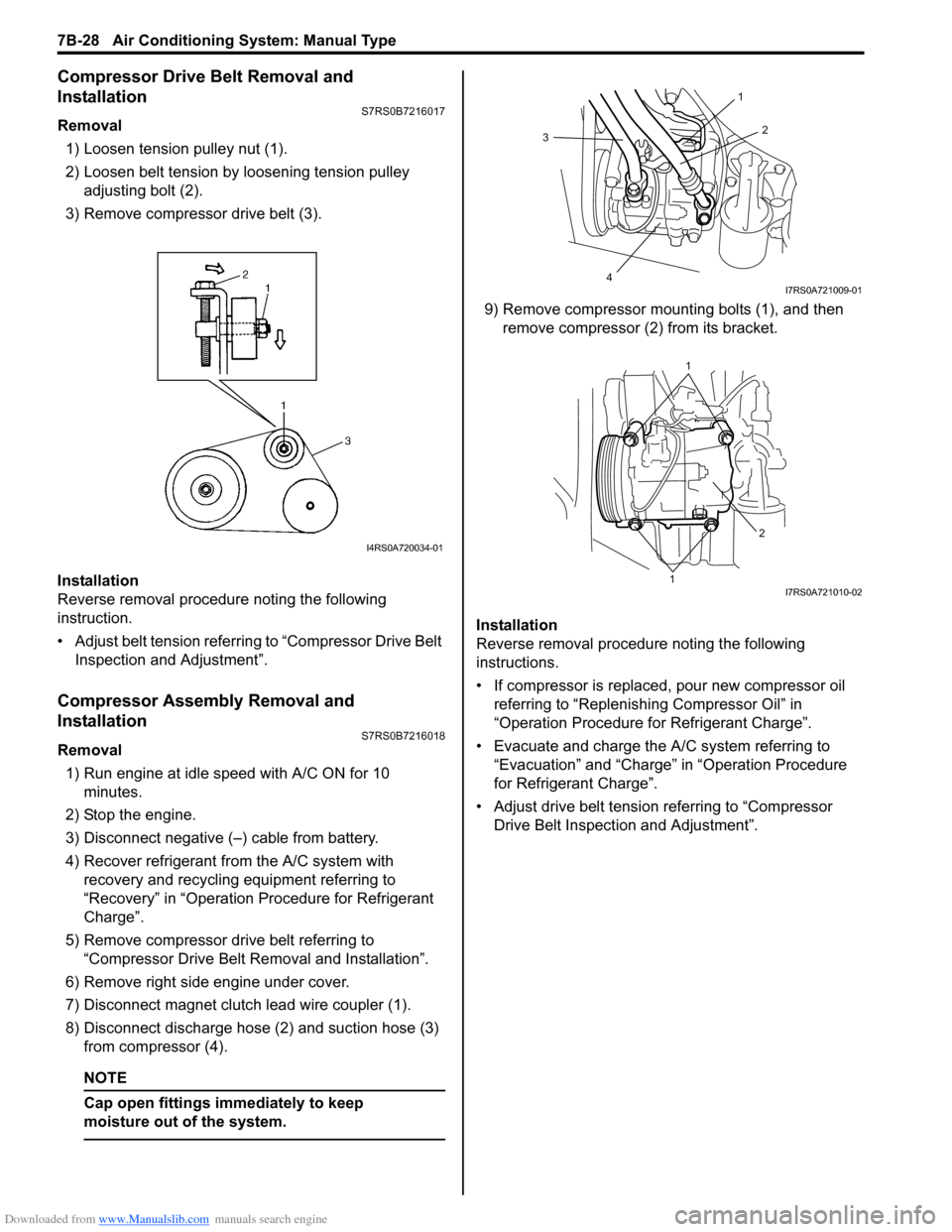
Downloaded from www.Manualslib.com manuals search engine 7B-28 Air Conditioning System: Manual Type
Compressor Drive Belt Removal and
Installation
S7RS0B7216017
Removal1) Loosen tension pulley nut (1).
2) Loosen belt tension by loosening tension pulley adjusting bolt (2).
3) Remove compressor drive belt (3).
Installation
Reverse removal procedure noting the following
instruction.
тАв Adjust belt tension referring to тАЬCompressor Drive Belt Inspection and AdjustmentтАЭ.
Compressor Assembly Removal and
Installation
S7RS0B7216018
Removal
1) Run engine at idle speed with A/C ON for 10 minutes.
2) Stop the engine.
3) Disconnect negative (тАУ) cable from battery.
4) Recover refrigerant fr om the A/C system with
recovery and recycling equipment referring to
тАЬRecoveryтАЭ in тАЬOperation Procedure for Refrigerant
ChargeтАЭ.
5) Remove compressor drive belt referring to тАЬCompressor Drive Belt Re moval and InstallationтАЭ.
6) Remove right side engine under cover.
7) Disconnect magnet clutch lead wire coupler (1).
8) Disconnect discharge hose (2) and suction hose (3) from compressor (4).
NOTE
Cap open fittings immediately to keep
moisture out of the system.
9) Remove compressor mounting bolts (1), and then remove compressor (2 ) from its bracket.
Installation
Reverse removal procedure noting the following
instructions.
тАв If compressor is replaced, pour new compressor oil referring to тАЬReplenishi ng Compressor OilтАЭ in
тАЬOperation Procedure for Refrigerant ChargeтАЭ.
тАв Evacuate and charge the A/C system referring to тАЬEvacuationтАЭ and тАЬChargeтАЭ in тАЬOperation Procedure
for Refrigerant ChargeтАЭ.
тАв Adjust drive belt tension referring to тАЬCompressor Drive Belt Inspecti on and AdjustmentтАЭ.
I4RS0A720034-01
3
4 2
1
I7RS0A721009-01
1
1 2
I7RS0A721010-02
Page 977 of 1496
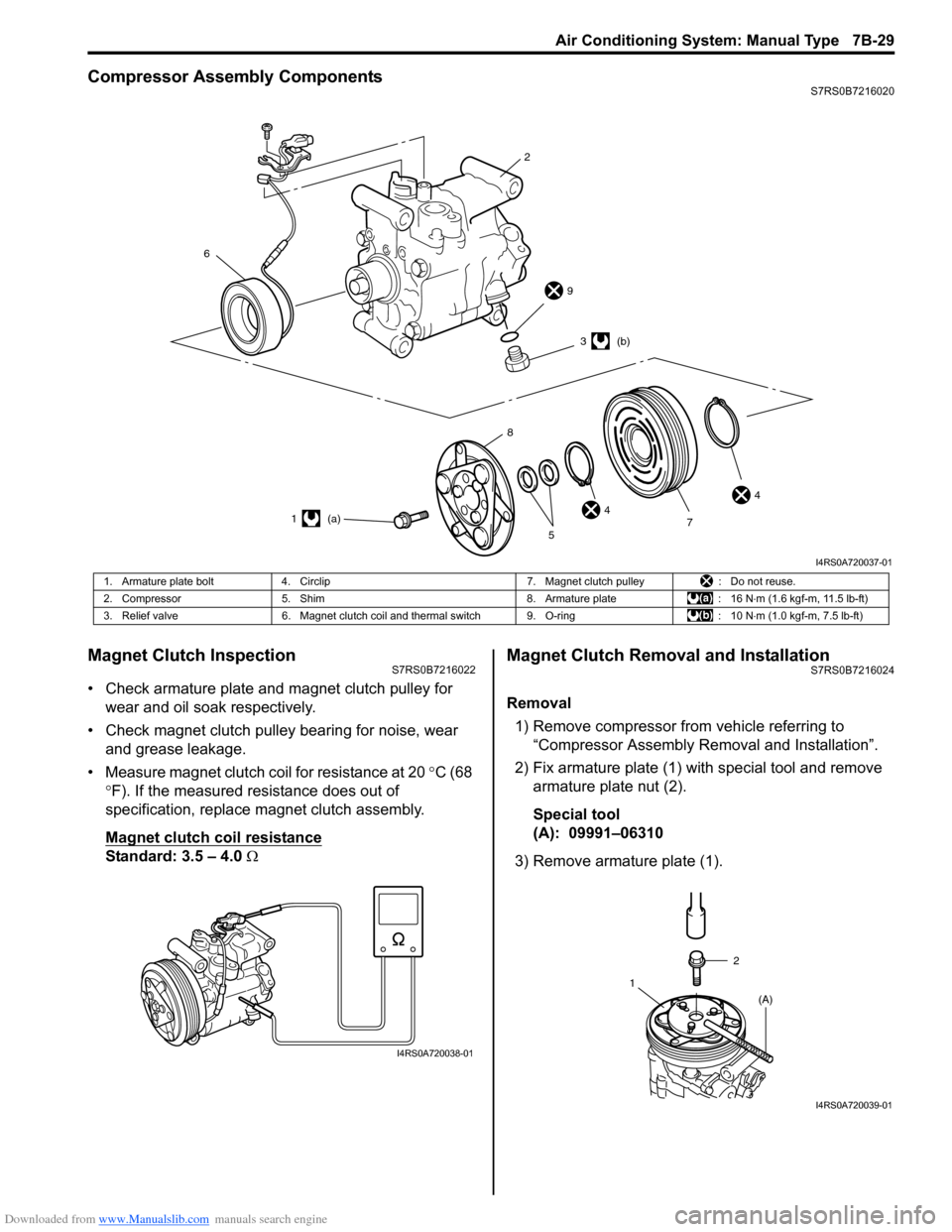
Downloaded from www.Manualslib.com manuals search engine Air Conditioning System: Manual Type 7B-29
Compressor Assembly ComponentsS7RS0B7216020
Magnet Clutch InspectionS7RS0B7216022
тАв Check armature plate and magnet clutch pulley for wear and oil soak respectively.
тАв Check magnet clutch pulley bearing for noise, wear and grease leakage.
тАв Measure magnet clutch coil for resistance at 20 ┬░C (68
┬░ F). If the measured resistance does out of
specification, replace magnet clutch assembly.
Magnet clutch coil resistance
Standard: 3.5 тАУ 4.0 тДж
Magnet Clutch Removal and InstallationS7RS0B7216024
Removal
1) Remove compressor from vehicle referring to тАЬCompressor Assembly Re moval and InstallationтАЭ.
2) Fix armature plate (1) with special tool and remove armature plate nut (2).
Special tool
(A): 09991тАУ06310
3) Remove armature plate (1).
6
2
9
44
3 (b)
1 (a) 7
5
8
I4RS0A720037-01
1. Armature plate bolt
4. Circlip 7. Magnet clutch pulley: Do not reuse.
2. Compressor 5. Shim 8. Armature plate: 16 NтЛЕm (1.6 kgf-m, 11.5 lb-ft)
3. Relief valve 6. Magnet clutch coil and thermal switch 9. O-ring : 10 NтЛЕm (1.0 kgf-m, 7.5 lb-ft)
I4RS0A720038-01
2
1 (A)
I4RS0A720039-01
Page 978 of 1496
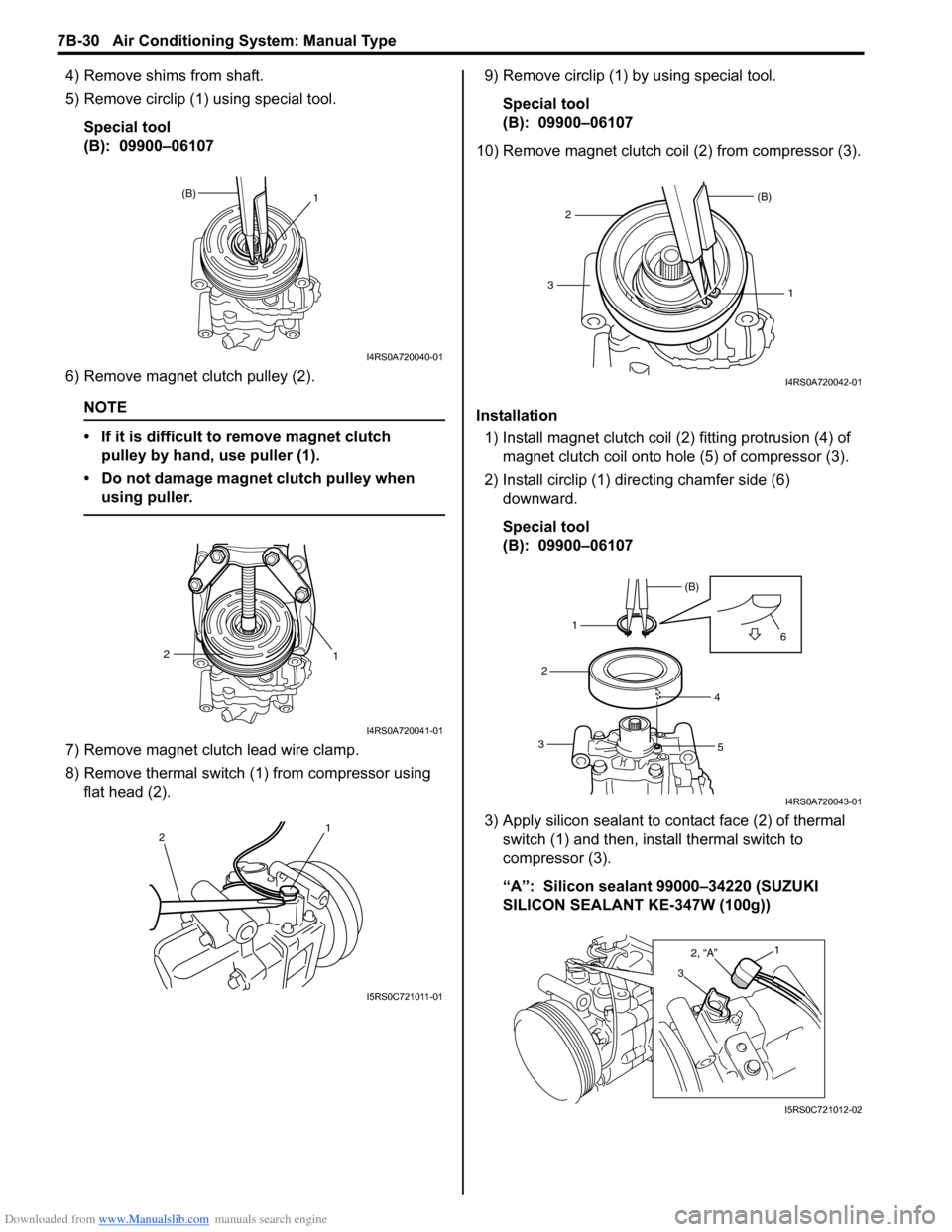
Downloaded from www.Manualslib.com manuals search engine 7B-30 Air Conditioning System: Manual Type
4) Remove shims from shaft.
5) Remove circlip (1) using special tool.Special tool
(B): 09900тАУ06107
6) Remove magnet clutch pulley (2).
NOTE
тАв If it is difficult to remove magnet clutch pulley by hand, use puller (1).
тАв Do not damage magnet clutch pulley when using puller.
7) Remove magnet clutch lead wire clamp.
8) Remove thermal switch (1) from compressor using flat head (2). 9) Remove circlip (1) by using special tool.
Special tool
(B): 09900тАУ06107
10) Remove magnet clutch coil (2) from compressor (3).
Installation 1) Install magnet clutch coil (2) fitting protrusion (4) of magnet clutch coil onto hole (5) of compressor (3).
2) Install circlip (1) dire cting chamfer side (6)
downward.
Special tool
(B): 09900тАУ06107
3) Apply silicon sealant to co ntact face (2) of thermal
switch (1) and then, inst all thermal switch to
compressor (3).
тАЬAтАЭ: Silicon sealant 99000тАУ34220 (SUZUKI
SILICON SEALANT KE-347W (100g))
(B) 1
I4RS0A720040-01
1
2
I4RS0A720041-01
2 1
I5RS0C721011-01
1
(B)
23
I4RS0A720042-01
1 (B)
2
3 4
5 6
I4RS0A720043-01
3
2, тАЬAтАЭ1
I5RS0C721012-02
Page 979 of 1496
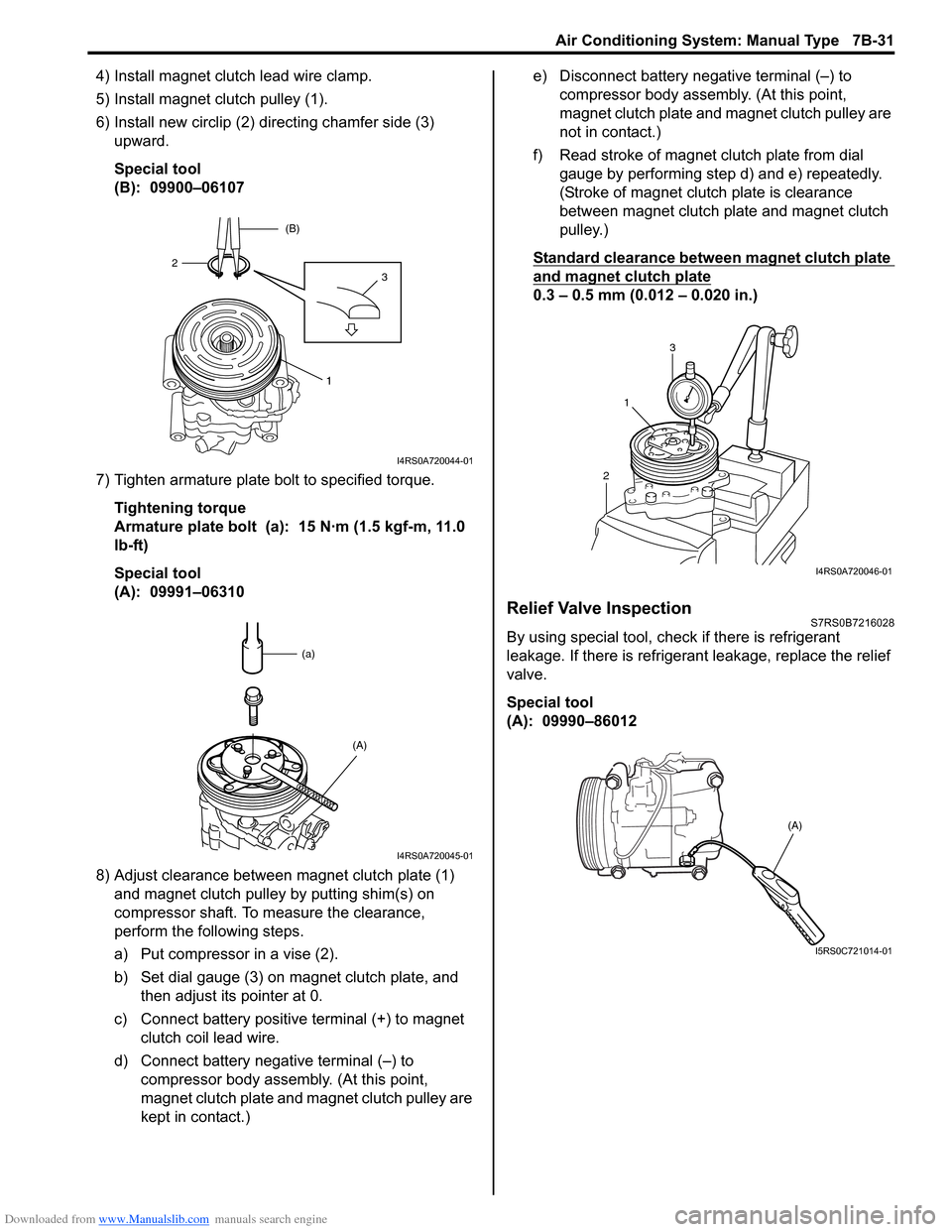
Downloaded from www.Manualslib.com manuals search engine Air Conditioning System: Manual Type 7B-31
4) Install magnet clutch lead wire clamp.
5) Install magnet clutch pulley (1).
6) Install new circlip (2) directing chamfer side (3) upward.
Special tool
(B): 09900тАУ06107
7) Tighten armature plate bolt to specified torque. Tightening torque
Armature plate bolt (a): 15 N┬╖m (1.5 kgf-m, 11.0
lb-ft)
Special tool
(A): 09991тАУ06310
8) Adjust clearance between magnet clutch plate (1) and magnet clutch pulley by putting shim(s) on
compressor shaft. To measure the clearance,
perform the following steps.
a) Put compressor in a vise (2).
b) Set dial gauge (3) on magnet clutch plate, and then adjust its pointer at 0.
c) Connect battery positive terminal (+) to magnet clutch coil lead wire.
d) Connect battery negative terminal (тАУ) to compressor body assemb ly. (At this point,
magnet clutch plate and magnet clutch pulley are
kept in contact.) e) Disconnect battery negative terminal (тАУ) to
compressor body assembly. (At this point,
magnet clutch plate and magnet clutch pulley are
not in contact.)
f) Read stroke of magnet clutch plate from dial gauge by performing step d) and e) repeatedly.
(Stroke of magnet clutch plate is clearance
between magnet clutch plate and magnet clutch
pulley.)
Standard clearance between magnet clutch plate
and magnet clutch plate
0.3 тАУ 0.5 mm (0.012 тАУ 0.020 in.)
Relief Valve InspectionS7RS0B7216028
By using special tool, chec k if there is refrigerant
leakage. If there is refrigerant leakage, replace the relief
valve.
Special tool
(A): 09990тАУ86012
1
32 (B)
I4RS0A720044-01
(a)
(A)
I4RS0A720045-01
21
3
I4RS0A720046-01
(A)
I5RS0C721014-01
Page 980 of 1496
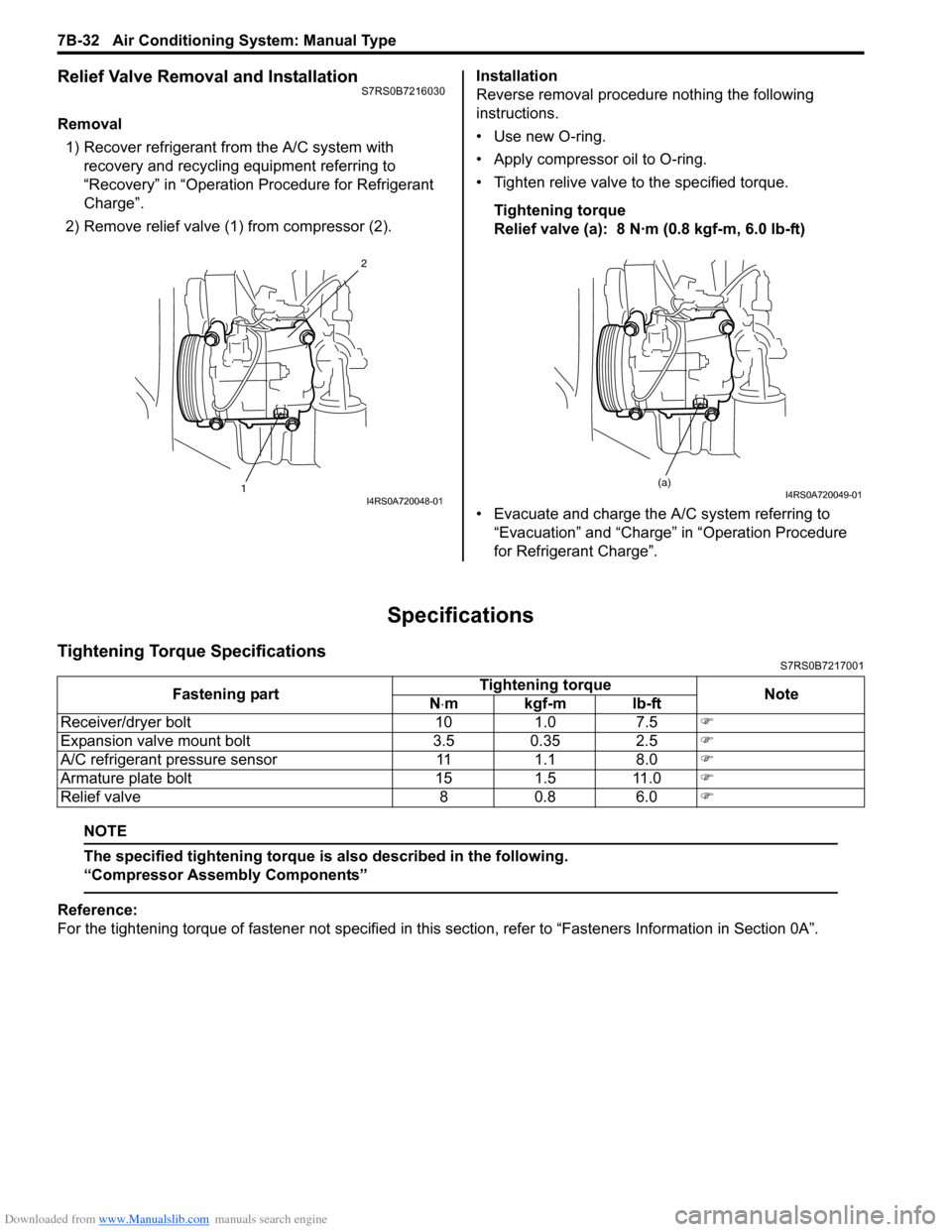
Downloaded from www.Manualslib.com manuals search engine 7B-32 Air Conditioning System: Manual Type
Relief Valve Removal and InstallationS7RS0B7216030
Removal1) Recover refrigerant fr om the A/C system with
recovery and recycling equipment referring to
тАЬRecoveryтАЭ in тАЬOperation Procedure for Refrigerant
ChargeтАЭ.
2) Remove relief valve (1) from compressor (2). Installation
Reverse removal procedure nothing the following
instructions.
тАв Use new O-ring.
тАв Apply compressor oil to O-ring.
тАв Tighten relive valve to the specified torque.
Tightening torque
Relief valve (a): 8 N┬╖m (0.8 kgf-m, 6.0 lb-ft)
тАв Evacuate and charge the A/C system referring to тАЬEvacuationтАЭ and тАЬChargeтАЭ in тАЬOperation Procedure
for Refrigerant ChargeтАЭ.
Specifications
Tightening Torque SpecificationsS7RS0B7217001
NOTE
The specified tightening torque is also described in the following.
тАЬCompressor Assembly ComponentsтАЭ
Reference:
For the tightening torque of fastener not specified in this section, refer to тАЬFasteners Information in Section 0AтАЭ.
12I4RS0A720048-01
(a)I4RS0A720049-01
Fastening part
Tightening torque
Note
N тЛЕmkgf-mlb-ft
Receiver/dryer bolt 10 1.0 7.5 �)
Expansion valve mount bolt 3.5 0.35 2.5 �)
A/C refrigerant pressure sensor 11 1.1 8.0 �)
Armature plate bolt 15 1.5 11.0 �)
Relief valve 8 0.8 6.0 �)
Page 981 of 1496
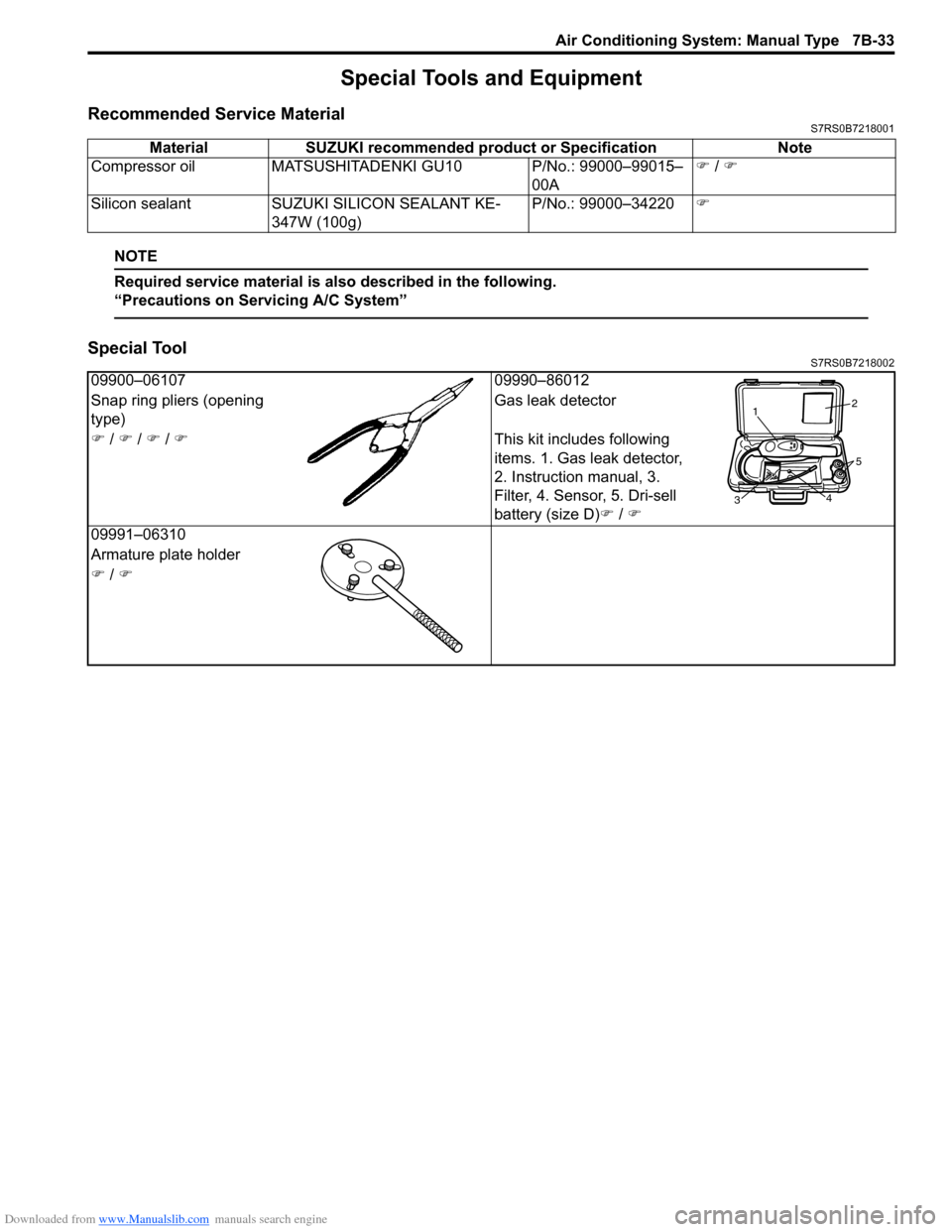
Downloaded from www.Manualslib.com manuals search engine Air Conditioning System: Manual Type 7B-33
Special Tools and Equipment
Recommended Service MaterialS7RS0B7218001
NOTE
Required service material is also described in the following.
тАЬPrecautions on Servicing A/C SystemтАЭ
Special ToolS7RS0B7218002
Material SUZUKI recommended product or Specification Note
Compressor oil MATSUSHITADEN KI GU10 P/No.: 99000тАУ99015тАУ
00A �)
/ �)
Silicon sealant SUZUKI SILICON SEALANT KE-
347W (100g) P/No.: 99000тАУ34220
�)
09900тАУ06107 09990тАУ86012
Snap ring pliers (opening
type) Gas leak detector
�) / �) / �) / �) This kit includes following
items. 1. Gas leak detector,
2. Instruction manual, 3.
Filter, 4. Sensor, 5. Dri-sell
battery (size D)�) / �)
09991тАУ06310
Armature plate holder
�) / �)
1 2
3 4
5
Page 984 of 1496

Downloaded from www.Manualslib.com manuals search engine 7B-36 Air Conditioning System: Automatic Type
Auto A/C Electronic Control Input / Output Table
HVAC Control Module Operation DescriptionS7RS0B7221002
Temperature Control
HVAC control module calculates the target temperature
control door position based on signals from the
temperature selector, inside air temperature sensor,
outside air temperature sensor and sunload sensor and
controls the temperature control actuator so that the
current position of the temperature control door matches
its target position.
Fan Speed Control
HVAC control module calculates the target blower fan
speed based on signals from the temperature selector,
inside air temperature sensor, outside air temperature
sensor and sunload sensor, compares it with the current
blower fan speed inputted from the blower motor
controller to control the current blower fan speed to the
target level.
Air Flow Outlet Control
HVAC control module calculates the target temperature
control door position based on signals from the
temperature selector, inside air temperature sensor,
outside air temperature sensor and sunload sensor.
Using thus obtained target temperature control door
position, it further calculates the target air flow control
door position and controls the ai r flow control actuator so
that the current air flow c ontrol door position becomes
the target position. Air Intake Position Control
HVAC control module determines the position of the air
intake control door based on signals from the
temperature selector, inside air temperature sensor,
outside air temperature sensor and sunload sensor and
selects any of the following positions by controlling the
position of the air intake control door.
тАв FRESH position (FRE)
тАв RECIRCULATION position (REC)
тАв MIX position (MIX)
Refrigerant Type IdentificationS7RS0B7221003
Refer to тАЬRefrigerant Type IdentificationтАЭ.
Sub-Cool A/C System DescriptionS7RS0B7221005
Refer to тАЬSub-Cool A/C System DescriptionтАЭ.
A/C Operation DescriptionS7RS0B7221006
Refer to тАЬA/C Operation DescriptionтАЭ.
Sunload sensor
Outside air temperature sensor Evaporator temperature sensor
A/C refrigerant pressure sensor
Temperature selector
MODE (air flow) selector
Blower speed selector
Air intake selector
AUTO switch
A/C switch
Compressor
Blower motor controller
Temperature control actuator
Air flow control actuator
Air intake control actuator
BCM
ECM
Data link connector
HVAC control module
CPU
ECT sensor
Inside air temperature sensor
VSS
*
I5RS0C722002-02
*: CAN communication
Page 987 of 1496
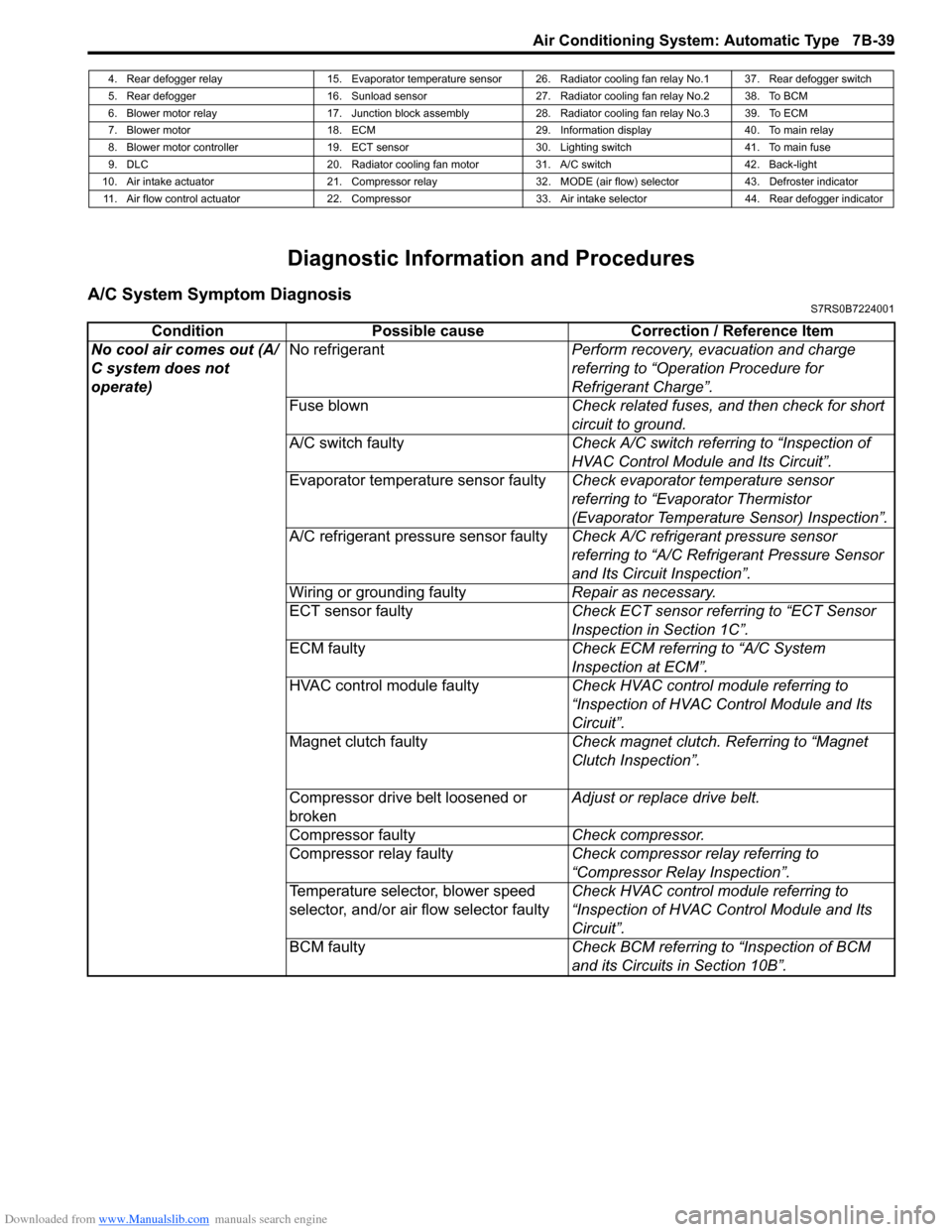
Downloaded from www.Manualslib.com manuals search engine Air Conditioning System: Automatic Type 7B-39
Diagnostic Information and Procedures
A/C System Symptom DiagnosisS7RS0B7224001
4. Rear defogger relay 15. Evaporator temperature sensor 26. Radiator cooling fan relay No.1 37. Rear defogger switch
5. Rear defogger 16. Sunload sensor 27. Radiator cooling fan relay No.2 38. To BCM
6. Blower motor relay 17. Junction block assembly 28. Radiator cooling fan relay No.3 39. To ECM
7. Blower motor 18. ECM 29. Information display 40. To main relay
8. Blower motor controller 19. ECT sensor 30. Lighting switch 41. To main fuse
9. DLC 20. Radiator cooling fan motor 31. A/C switch 42. Back-light
10. Air intake actuator 21. Compressor relay 32. MODE (air flow) selector 43. Defroster indicator 11. Air flow control actuator 22. Compressor 33. Air intake selector 44. Rear defogger indicator
Condition Possible cause Correction / Reference Item
No cool air comes out (A/
C system does not
operate) No refrigerant
Perform recovery, evacuation and charge
referring to тАЬOperation Procedure for
Refrigerant ChargeтАЭ.
Fuse blown Check related fuses, and then check for short
circuit to ground.
A/C switch faulty Check A/C switch referring to тАЬInspection of
HVAC Control Module and Its CircuitтАЭ.
Evaporator temperature sensor faulty Check evaporator temperature sensor
referring to тАЬEvaporator Thermistor
(Evaporator Temperature Sensor) InspectionтАЭ.
A/C refrigerant pressure sensor faulty Check A/C refrigerant pressure sensor
referring to тАЬA/C Refrigerant Pressure Sensor
and Its Circuit InspectionтАЭ.
Wiring or grounding faulty Repair as necessary.
ECT sensor faulty Check ECT sensor referring to тАЬECT Sensor
Inspection in Section 1CтАЭ.
ECM faulty Check ECM referring to тАЬA/C System
Inspection at ECMтАЭ.
HVAC control module faulty Check HVAC control module referring to
тАЬInspection of HVAC Control Module and Its
CircuitтАЭ.
Magnet clutch faulty Check magnet clutch. Referring to тАЬMagnet
Clutch InspectionтАЭ.
Compressor drive belt loosened or
broken Adjust or replace drive belt.
Compressor faulty Check compressor.
Compressor relay faulty Check compressor relay referring to
тАЬCompressor Relay InspectionтАЭ.
Temperature selector, blower speed
selector, and/or air flow selector faulty Check HVAC control module referring to
тАЬInspection of HVAC Control Module and Its
CircuitтАЭ.
BCM faulty Check BCM referring to тАЬInspection of BCM
and its Circuits in Section 10BтАЭ.
Page 989 of 1496
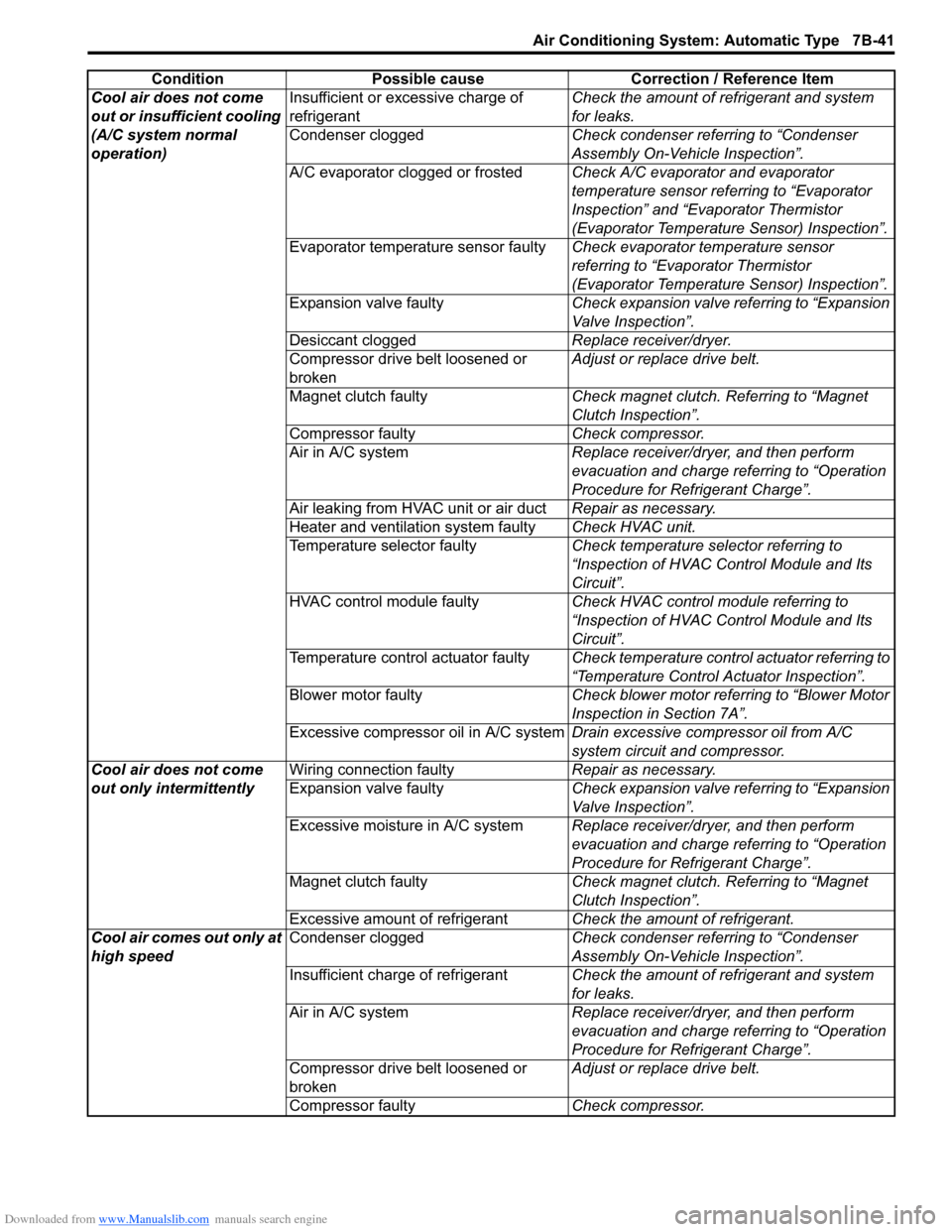
Downloaded from www.Manualslib.com manuals search engine Air Conditioning System: Automatic Type 7B-41
Cool air does not come
out or insufficient cooling
(A/C system normal
operation)Insufficient or excessive charge of
refrigerant
Check the amount of refrigerant and system
for leaks.
Condenser clogged Check condenser referring to тАЬCondenser
Assembly On-Vehicle InspectionтАЭ.
A/C evaporator clogged or frosted Check A/C evaporator and evaporator
temperature sensor referring to тАЬEvaporator
InspectionтАЭ and тАЬEvaporator Thermistor
(Evaporator Temperature Sensor) InspectionтАЭ.
Evaporator temperature sensor faulty Check evaporator temperature sensor
referring to тАЬEvaporator Thermistor
(Evaporator Temperature Sensor) InspectionтАЭ.
Expansion valve faulty Check expansion valve referring to тАЬExpansion
Valve InspectionтАЭ.
Desiccant clogged Replace receiver/dryer.
Compressor drive belt loosened or
broken Adjust or replace drive belt.
Magnet clutch faulty Check magnet clutch. Referring to тАЬMagnet
Clutch InspectionтАЭ.
Compressor faulty Check compressor.
Air in A/C system Replace receiver/dryer, and then perform
evacuation and charge referring to тАЬOperation
Procedure for Refrigerant ChargeтАЭ.
Air leaking from HVAC unit or air duct Repair as necessary.
Heater and ventilation system faulty Check HVAC unit.
Temperature selector faulty Check temperature selector referring to
тАЬInspection of HVAC Control Module and Its
CircuitтАЭ.
HVAC control module faulty Check HVAC control module referring to
тАЬInspection of HVAC Control Module and Its
CircuitтАЭ.
Temperature control actuator faulty Check temperature control actuator referring to
тАЬTemperature Control Actuator InspectionтАЭ.
Blower motor faulty Check blower motor referring to тАЬBlower Motor
Inspection in Section 7AтАЭ.
Excessive compressor oil in A/C system Drain excessive compressor oil from A/C
system circuit and compressor.
Cool air does not come
out only intermittently Wiring connection faulty
Repair as necessary.
Expansion valve faulty Check expansion valve referring to тАЬExpansion
Valve InspectionтАЭ.
Excessive moisture in A/C system Replace receiver/dryer, and then perform
evacuation and charge referring to тАЬOperation
Procedure for Refrigerant ChargeтАЭ.
Magnet clutch faulty Check magnet clutch. Referring to тАЬMagnet
Clutch InspectionтАЭ.
Excessive amount of refrigerant Check the amount of refrigerant.
Cool air comes out only at
high speed Condenser clogged
Check condenser referring to тАЬCondenser
Assembly On-Vehicle InspectionтАЭ.
Insufficient charge of refrigerant Check the amount of refrigerant and system
for leaks.
Air in A/C system Replace receiver/dryer, and then perform
evacuation and charge referring to тАЬOperation
Procedure for Refrigerant ChargeтАЭ.
Compressor drive belt loosened or
broken Adjust or replace drive belt.
Compressor faulty Check compressor.
Condition Possible cause Correction / Reference Item
Page 995 of 1496
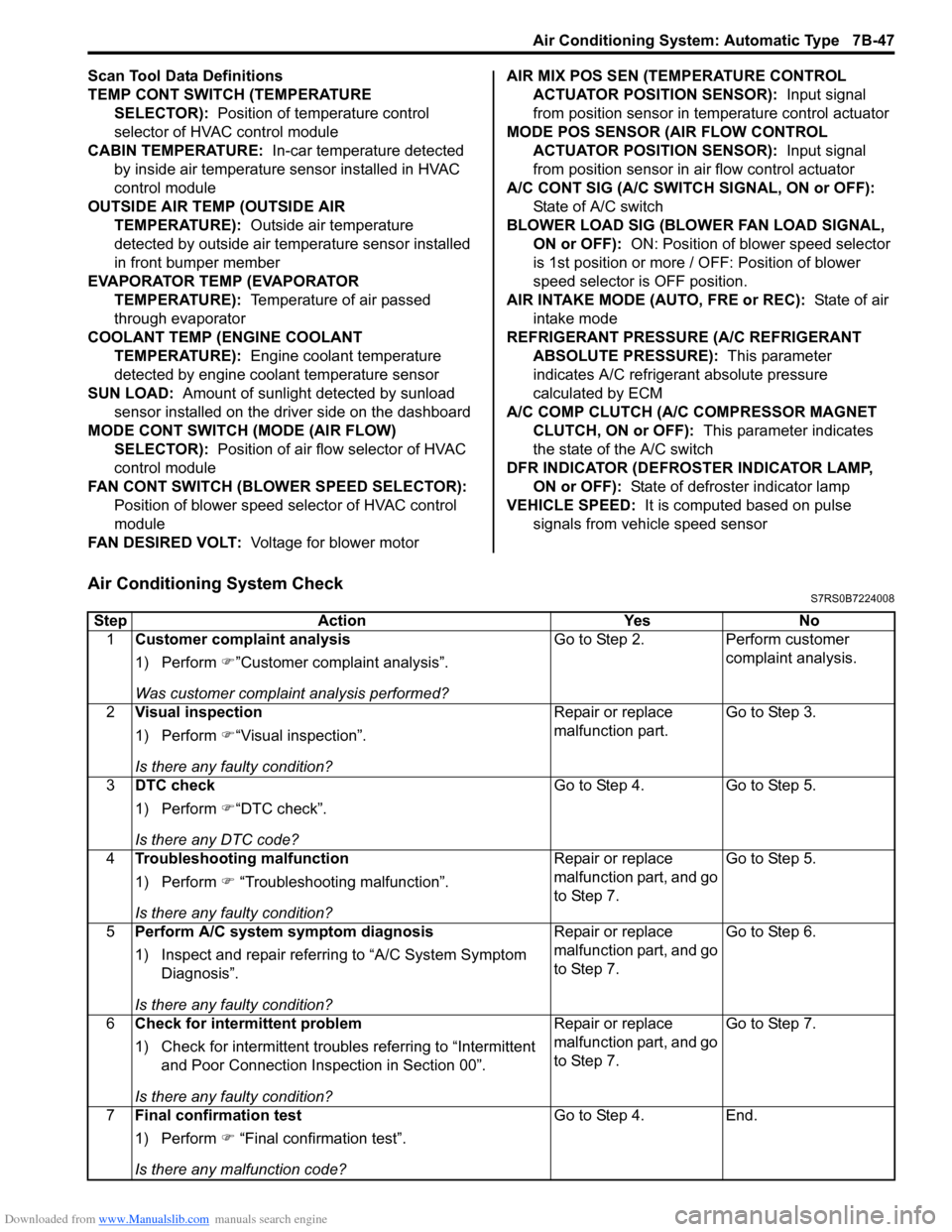
Downloaded from www.Manualslib.com manuals search engine Air Conditioning System: Automatic Type 7B-47
Scan Tool Data Definitions
TEMP CONT SWITCH (TEMPERATURE SELECTOR): Position of temperature control
selector of HVAC control module
CABIN TEMPERATURE: In-car temperature detected
by inside air temperature sensor installed in HVAC
control module
OUTSIDE AIR TEMP (OUTSIDE AIR TEMPERATURE): Outside air temperature
detected by outside air temperature sensor installed
in front bumper member
EVAPORATOR TEMP (EVAPORATOR TEMPERATURE): Temperature of air passed
through evaporator
COOLANT TEMP (ENGINE COOLANT TEMPERATURE): Engine coolant temperature
detected by engine coolant temperature sensor
SUN LOAD: Amount of sunlight detected by sunload
sensor installed on the driver side on the dashboard
MODE CONT SWITCH (MODE (AIR FLOW) SELECTOR): Position of air flow selector of HVAC
control module
FAN CONT SWITCH (BLOWER SPEED SELECTOR): Position of blower speed selector of HVAC control
module
FAN DESIRED VOLT: Voltage for blower motor AIR MIX POS SEN (TEMPERATURE CONTROL
ACTUATOR POSITI ON SENSOR): Input signal
from position sensor in temperature control actuator
MODE POS SENSOR (AIR FLOW CONTROL ACTUATOR POSITI ON SENSOR): Input signal
from position sensor in air flow control actuator
A/C CONT SIG (A/C SWITCH SIGNAL, ON or OFF): State of A/C switch
BLOWER LOAD SIG (BLO WER FAN LOAD SIGNAL,
ON or OFF): ON: Position of blower speed selector
is 1st position or more / OFF: Position of blower
speed selector is OFF position.
AIR INTAKE MODE (AUTO, FRE or REC): State of air
intake mode
REFRIGERANT PRESSURE (A/C REFRIGERANT ABSOLUTE PRESSURE): This parameter
indicates A/C refrigerant absolute pressure
calculated by ECM
A/C COMP CLUTCH (A/C COMPRESSOR MAGNET CLUTCH, ON or OFF): This parameter indicates
the state of the A/C switch
DFR INDICATOR (DEFROSTER INDICATOR LAMP, ON or OFF): State of defroster indicator lamp
VEHICLE SPEED: It is computed based on pulse
signals from vehicle speed sensor
Air Conditioning System CheckS7RS0B7224008
Step Action YesNo
1 Customer complaint analysis
1) Perform �)тАЭCustomer complaint analysisтАЭ.
Was customer complaint analysis performed? Go to Step 2.
Perform customer
complaint analysis.
2 Visual inspection
1) Perform �)тАЬVisual inspectionтАЭ.
Is there any faulty condition? Repair or replace
malfunction part.
Go to Step 3.
3 DTC check
1) Perform �)тАЬDTC checkтАЭ.
Is there any DTC code? Go to Step 4.
Go to Step 5.
4 Troubleshooting malfunction
1) Perform �) тАЬTroubleshooting malfunctionтАЭ.
Is there any faulty condition? Repair or replace
malfunction part, and go
to Step 7.
Go to Step 5.
5 Perform A/C system symptom diagnosis
1) Inspect and repair referri ng to тАЬA/C System Symptom
DiagnosisтАЭ.
Is there any faulty condition? Repair or replace
malfunction part, and go
to Step 7.
Go to Step 6.
6 Check for intermittent problem
1) Check for intermittent troubles referring to тАЬIntermittent
and Poor Connection Inspection in Section 00тАЭ.
Is there any faulty condition? Repair or replace
malfunction part, and go
to Step 7.
Go to Step 7.
7 Final confirmation test
1) Perform �) тАЬFinal confirmation testтАЭ.
Is there any malfunction code? Go to Step 4.
End.